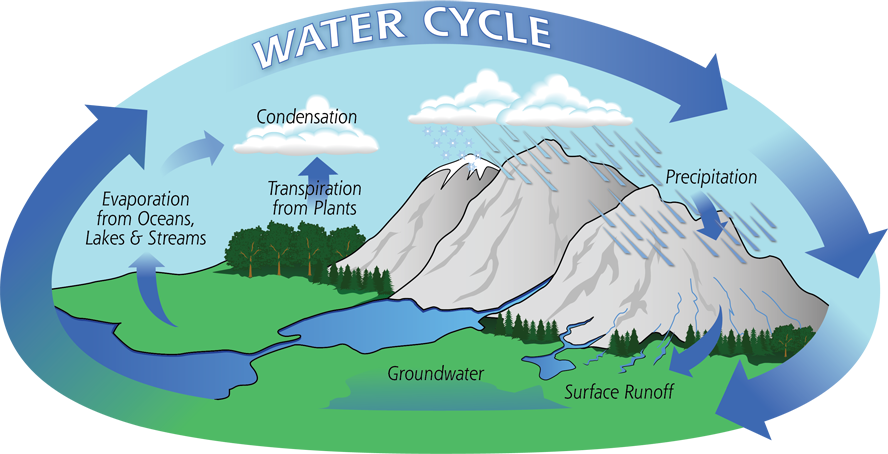Monday 10 November 2014
Tuesday 10 June 2014
The Water Cycle
The Water Cycle
The water cycle is like movement of water flowing through the earth's surface, atmosphere, and underground. Water is moving through this earth as we speak and it is because the process of evaporation, precipitation, transpiration, condensation and runoff.Water in water cycles can be made a solid, liquid or gas.The water cycle is very important to the life on earth.Water is a recourse and can not be made by men.Transpiration is the process of water moving from one thing and going up into the atmosphere.About 70% of our earth is covered with water.Water is being recycled everyday... so the water you drink could be the water dinosaurs drank millions of years ago.Evaporation: Water that rises from the lakes & streams.Condensation: Water that has evaporated into the cloud and stays inside the cloud until the cloud is full.Transpiration: water that rises from plants into clouds.Precipitation: When water comes out of the clouds also known as rain, and falls on mountains.Surface Runoff: When the water falls off the mountain and into the ground. http://www.softschools.com/facts/earth_systems/water_cycle_facts/413/By Keti.F
http://www.softschools.com/facts/earth_systems/water_cycle_facts/413/By Keti.F
The water cycle is like movement of water flowing through the earth's surface, atmosphere, and underground. Water is moving through this earth as we speak and it is because the process of evaporation, precipitation, transpiration, condensation and runoff.Water in water cycles can be made a solid, liquid or gas.The water cycle is very important to the life on earth.Water is a recourse and can not be made by men.Transpiration is the process of water moving from one thing and going up into the atmosphere.About 70% of our earth is covered with water.Water is being recycled everyday... so the water you drink could be the water dinosaurs drank millions of years ago.Evaporation: Water that rises from the lakes & streams.Condensation: Water that has evaporated into the cloud and stays inside the cloud until the cloud is full.Transpiration: water that rises from plants into clouds.Precipitation: When water comes out of the clouds also known as rain, and falls on mountains.Surface Runoff: When the water falls off the mountain and into the ground.
Thursday 15 May 2014
Commercial Fishing in New Zealand
- New Zealand commercial fishing sector has built up over the last 30 years.
- In the 1970s our fishing industry was largely an inshore affair.
- Offshore waters, beyond our 12 nautical mile Territorial Sea, were fished by Japanese, Taiwanese, Korean, and Soviet vessels.
- With the introduction of the 200 nautical mile exclusive economic zone in 1977 and the introduction of the quota management system in 1986, many New Zealand companies went on to invest in fishing vessels to fish the available catch and onshore factories to process the catch.
- The industry has also grown from being a predominantly domestic supplier to one of the nation’s leading export industries.
- In excess of 90 percent of all fish landed is exported.
Facts on waves
1.Waves are mainly a product of the wind.
2.The best waves for surfing are the result of the interaction of winds on the surface of the ocean, far away from the coast.
3.Wind is the first step in the formation of surfable waves.
4.Local shore winds can also produce waves, but they can also destroy the quality of the breaking waves.
5. Local shore winds can also produce waves, but they can also destroy the quality of the breaking waves.
Tuesday 13 May 2014
Hunting the Hunter
Facts!
*Not all spiders catch their food in sticky silk.
*Six of a hunting spider eight eye work like mirrors. They reflect back a little of any light that reaches them.
*If its carrying a egg sac or even piggy-backing its babies, you'll know that its a female spider.
*Most spiders are active at night. This helps them avoid being eaten by birds.
This story is about different kinds of spider.
Written by Mary Sutherland.
*Not all spiders catch their food in sticky silk.
*Six of a hunting spider eight eye work like mirrors. They reflect back a little of any light that reaches them.
*If its carrying a egg sac or even piggy-backing its babies, you'll know that its a female spider.
*Most spiders are active at night. This helps them avoid being eaten by birds.
This story is about different kinds of spider.
Written by Mary Sutherland.
Thursday 17 April 2014
Thursday 3 April 2014
Wednesday 19 March 2014
The Weta
1. The Weta is only found in New Zealand.
2. The Weta is so old that it has outlived dinosaurs.
3. The Weta is sometimes called the dinosaur of the incest sites.
5. There are 11 species of Giant Weta.
Friday 14 March 2014
Thursday 13 March 2014
The Weka
The Weka.
The weka is a nocturnal creature and it searches for food in the night time.The Weka mainly eats invertebrates and fruit.They sometimes eat chitons and other rocky coast invertebrates, lizards, rodents, food scraps, carrion, and the eggs and young of other groundnesting birds.
Here are some sites that you could find some more facts about the Weka.
The Kakapo
The Kakapo is a large parrot. The male Kakapo measures up to at least 60 cm and weighs from 2 to 4 kg when it has fully matured. The Kakapo can not fly because of its shot wings that anchor flight muscles. The Kakapos body has yellowish, greenish feather with black and dark brownish blending in with the other feathers. There are less than 100 kakapo left. The Kakapo lived in New Zealand and for many years were inhabited by birds and reptiles that had no predatory mammals. The Kakapo can live up to average of 90 years but the maximum is 120 years.
These are some other sites you could get some more information from.

http://savethekakapo.weebly.com/fun-facts.html
http://en.wikipedia.org/wiki/Kakapo
Monday 10 March 2014
Subscribe to:
Posts (Atom)







